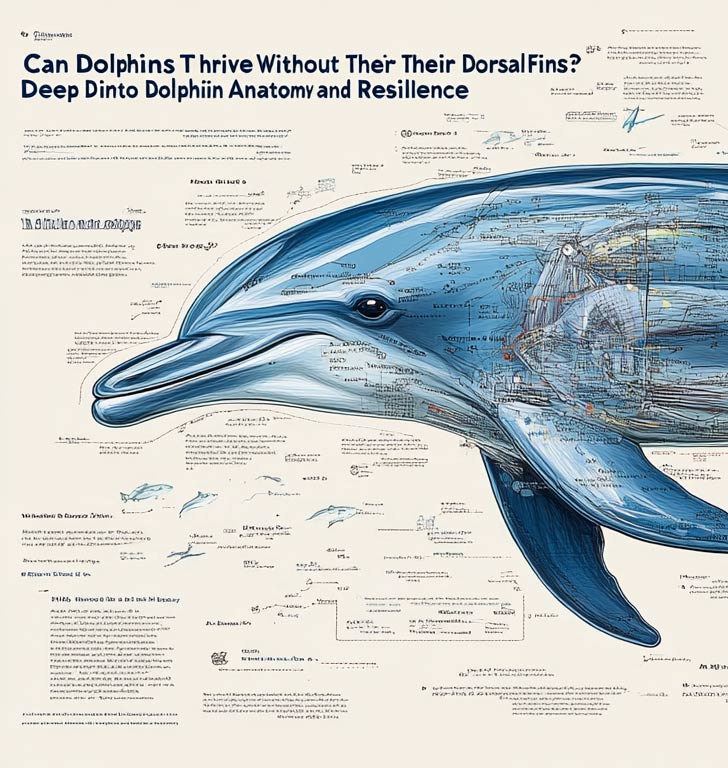Dolphins are some of the ocean’s most agile and playful creatures, renowned for their intelligence, social behaviors, and streamlined bodies built for life in the water. Central to a dolphin’s speed and stability in the ocean is its dorsal fin—a unique structure that helps with movement and balance. But what happens if a dolphin loses this essential fin? Can they continue to survive, and if so, how does it affect their life? In this post, we explore the role of the dorsal fin, what happens when a dolphin loses it, and whether dolphins have the ability to regenerate this critical body part.
The dorsal fin serves as more than just a recognizable feature of a dolphin’s silhouette. It plays a crucial role in their daily life, providing benefits that contribute to their health and survival.
- Stabilization: The dorsal fin acts like a keel on a boat, helping stabilize the dolphin as it moves through the water. This stability is essential for maintaining a streamlined form, which allows for efficient swimming and quick maneuvering.
- Thermoregulation: Dolphins are warm-blooded and need to regulate their body temperature in various water temperatures. The dorsal fin aids in thermoregulation by acting as a heat exchange system, helping to cool the dolphin’s body as they swim in warmer waters.
- Social Communication: Dolphins use body language extensively, and the dorsal fin plays a part in their social dynamics. Dolphins recognize each other’s dorsal fins, which are often uniquely marked with nicks, scars, and scratches over time. These marks allow dolphins to identify individuals and communicate within their social groups.
- Directional Control: While the tail fin, or fluke, is the primary driver of speed, the dorsal fin helps with direction and balance, allowing the dolphin to maintain a steady course or pivot sharply when needed. This function is critical when escaping predators or pursuing prey.
In short, the dorsal fin is a multi-functional adaptation that supports a dolphin’s lifestyle and survival in numerous ways.
Can Dolphins Survive Without a Dorsal Fin?
Though the dorsal fin is highly beneficial, there are cases of dolphins surviving without it. Dolphins that have lost their dorsal fins due to injury, entanglement, or even shark attacks can still live relatively normal lives, although there are challenges.
- Increased Effort in Swimming: Without the dorsal fin, a dolphin’s stability is compromised, which can make swimming more tiring. Dolphins without dorsal fins have to work harder to keep a balanced posture and maintain direction.
- Social Integration: Dolphins with missing dorsal fins may face some initial social challenges. However, dolphins are highly adaptable and social animals, and they generally adjust and continue interacting within their pods.
- Heat Regulation Challenges: The dorsal fin’s role in thermoregulation means that dolphins without it might struggle more in regulating their body heat in warmer water, potentially leading to overheating.
While a dorsal fin provides significant advantages, dolphins can adapt to its absence. There have been observed cases of dolphins surviving and thriving in the wild even after dorsal fin loss. This adaptability showcases the dolphin’s remarkable resilience and ability to adjust to physical changes.
Do Dolphins’ Fins Grow Back?
Unfortunately, like many animals, dolphins lack the ability to regenerate major body parts once they are fully developed. When a dorsal fin is lost or damaged, it will not grow back. This loss is permanent, meaning that dolphins must adapt to life without the missing fin.
However, dolphins have been observed to recover from injuries and adapt their behaviors to compensate for lost appendages. Marine biologists have documented cases of dolphins with missing dorsal fins still living full lives in the wild, albeit with certain adjustments in swimming and social interactions. Their survival, even without a dorsal fin, illustrates their impressive adaptability.

Key Takeaways
- Dorsal Fin Functions:
- Stabilizes swimming, enabling speed and agility.
- Helps regulate body temperature in varying water conditions.
- Plays a role in social interactions and identification.
- Assists with directional control and maneuverability.
- Dorsal Fin Loss:
- Dolphins can survive without a dorsal fin, but with additional challenges.
- Without a dorsal fin, dolphins may need more energy for swimming and might experience difficulty in thermoregulation.
- The dorsal fin does not regenerate, so the adaptation is essential for dolphins missing this fin.
Studying these unique cases not only enhances our understanding of dolphins but also provides insight into the resilience of marine life in the face of adversity. Dolphins continue to inspire us with their strength and adaptability, reminding us of nature’s incredible capacity for survival.











